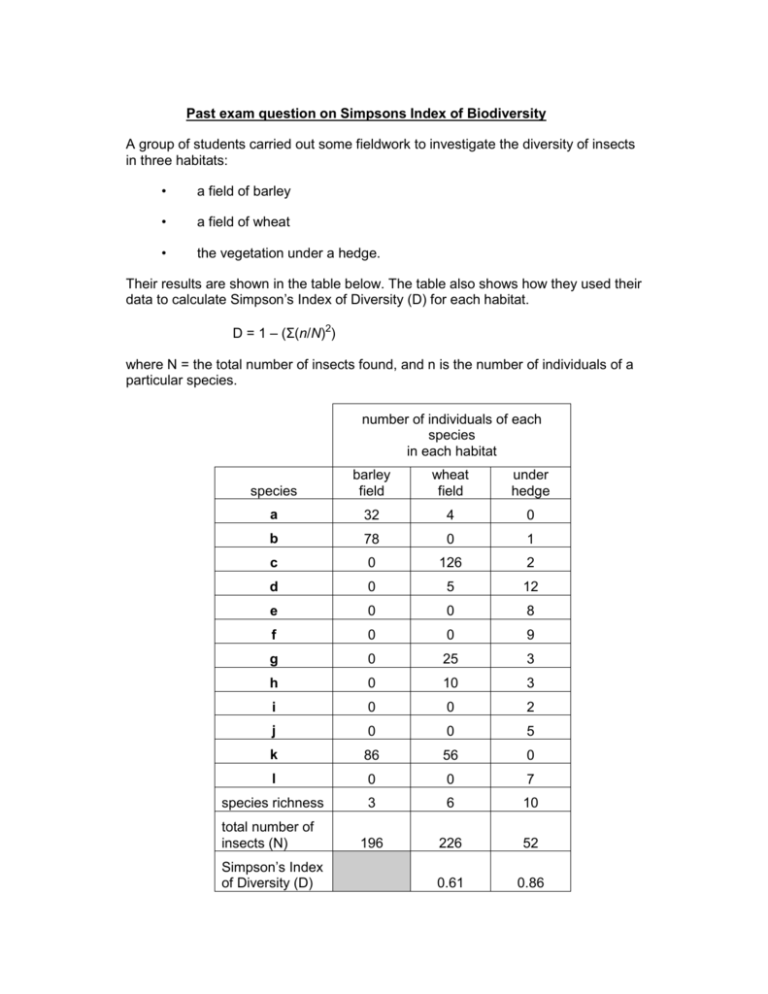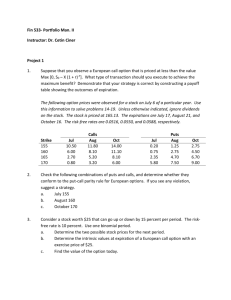Simpson's Index of Biodiversity Exam Question
advertisement

Past exam question on Simpsons Index of Biodiversity A group of students carried out some fieldwork to investigate the diversity of insects in three habitats: • a field of barley • a field of wheat • the vegetation under a hedge. Their results are shown in the table below. The table also shows how they used their data to calculate Simpson’s Index of Diversity (D) for each habitat. D = 1 – (Σ(n/N)2) where N = the total number of insects found, and n is the number of individuals of a particular species. number of individuals of each species in each habitat species barley field wheat field under hedge a 32 4 0 b 78 0 1 c 0 126 2 d 0 5 12 e 0 0 8 f 0 0 9 g 0 25 3 h 0 10 3 i 0 0 2 j 0 0 5 k 86 56 0 l 0 0 7 species richness 3 6 10 196 226 52 0.61 0.86 total number of insects (N) Simpson’s Index of Diversity (D) (a) State what is meant by the term species richness. ......................................................................................................................... ......................................................................................................................... [1] (b) (i) Calculate the value for Simpson’s Index of Diversity (D) for the barley field. Show your working and write your answer in the shaded box in the table. [2] (ii) Using the data in the table, suggest why the value of Simpson’s Index of Diversity (D) for the vegetation under the hedge is so much higher than that for the wheat field. ................................................................................................................ ................................................................................................................ ................................................................................................................ ................................................................................................................ [3] (c) Describe how the students may have determined the numbers of individuals of each species in each habitat. ......................................................................................................................... ......................................................................................................................... ......................................................................................................................... ......................................................................................................................... ......................................................................................................................... ......................................................................................................................... ......................................................................................................................... ......................................................................................................................... ......................................................................................................................... [5] [Total 11 marks] Mark Scheme (a) number of different species present/AW; (b) (i) 0.62;; award one mark if working correct but answer wrong (ii) 1 2 award marks only if comparative points given hedge vegetation has greater species richness than wheat; numbers of insects under hedge more evenly spread compared with numbers in wheat field / AW; more niches for insects in vegetation under hedge/ more species of plants grow under hedge than in wheat field/ AW; ref. use of, chemicals/ insecticides/herbicides, on wheat and not on hedge vegetation; AVP; e.g. ref. plants under hedge more likely to be wild/native compared with wheat crop / AW (c) max 3 Any four from the following: ref. random samples; sweep net; repeats in each habitat; ref need for same technique in each habitat; classify and count numbers of each species(of insect) caught; AVP; e.g. further detail of sampling such as use of suitable chemical to stun the insects; max 5 [11]









